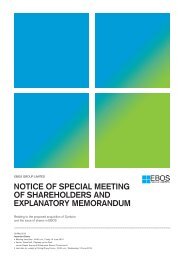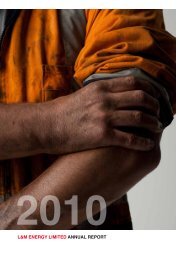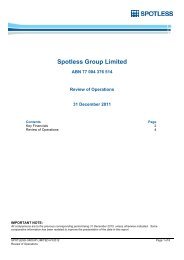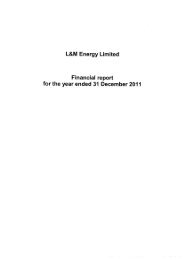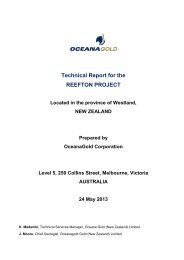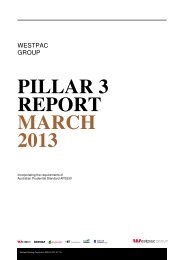NZSX/ NZDX Listing Rules APPENDIX 1 Part A (Rules 10.4.2 ... - NZX
NZSX/ NZDX Listing Rules APPENDIX 1 Part A (Rules 10.4.2 ... - NZX
NZSX/ NZDX Listing Rules APPENDIX 1 Part A (Rules 10.4.2 ... - NZX
Create successful ePaper yourself
Turn your PDF publications into a flip-book with our unique Google optimized e-Paper software.
THE 2004 AUSTRALASIAN CODE FOR REPORTING EXPLORATION RESULTS, MINERAL RESOURCES AND ORE RESERVES (THE JORC CODE)<br />
38.The terms ‘Mineral Resource(s)’ and ‘Ore Reserve(s)’,<br />
and the subdivisions of these as defined above, apply<br />
also to coal reporting, but if preferred by the reporting<br />
company, the terms ‘Coal Resource(s)’ and ‘Coal<br />
Reserve(s)’ and the appropriate subdivisions may be<br />
substituted.<br />
39.‘Marketable Coal Reserves’, representing beneficiated<br />
or otherwise enhanced coal product where<br />
modifications due to mining, dilution and processing<br />
have been considered, may be publicly reported in<br />
conjunction with, but not instead of, reports of Ore (Coal)<br />
Reserves. The basis of the predicted yield to achieve<br />
Marketable Coal Reserves should be stated.<br />
REPORTING OF DIAMOND EXPLORATION RESULTS,<br />
MINERAL RESOURCES AND ORE RESERVES<br />
40.Clauses 40 to 43 of the Code address matters that relate<br />
specifically to the Public Reporting of Exploration Results,<br />
Mineral Resources and Ore Reserves for diamonds and<br />
other gemstones. Unless otherwise stated, Clauses 1 to<br />
36 of this Code (including Figure 1) apply. Table 1, as<br />
part of the guidelines, should be considered persuasive<br />
when reporting Exploration Results, Mineral Resources<br />
and Ore Reserves for diamonds and other gemstones.<br />
For the purposes of Public Reporting, the<br />
requirements for diamonds and other gemstones are<br />
generally similar to those for other commodities with<br />
the replacement of terms such as ‘mineral’ by<br />
‘diamond’ and ‘grade’ by ‘grade and average<br />
diamond value’. The term ‘quality’ should not be<br />
substituted for ‘grade,’ since in diamond deposits<br />
these have distinctly separate meanings. Other<br />
industry guidelines on the estimation and reporting<br />
of diamond resources and reserves may be useful<br />
but will not under any circumstances override the<br />
provisions and intentions of the JORC Code.<br />
A number of characteristics of diamond deposits are<br />
different from those of, for example, typical<br />
metalliferous and coal deposits and therefore require<br />
special consideration. These include the generally<br />
low mineral content and variability of primary and<br />
placer deposits, the particulate nature of diamonds,<br />
the specialised requirement for diamond valuation<br />
and the inherent difficulties and uncertainties in the<br />
estimation of diamond resources and reserves.<br />
41. Reports of diamonds recovered from sampling programs<br />
must provide material information relating to the basis<br />
on which the sample is taken, the method of recovery<br />
and the recovery of the diamonds. The weight of<br />
diamonds recovered may only be omitted from the report<br />
when the diamonds are considered to be too small to<br />
be of commercial significance. This lower cut-off size<br />
should be stated.<br />
The stone size distribution and price of diamonds<br />
and other gemstones are critical components of the<br />
resource and reserve estimates. At an early exploration<br />
stage, sampling and delineation drilling will not<br />
usually provide this information, which relies on large<br />
diameter drilling and, in particular, bulk sampling.<br />
In order to demonstrate that a resource has reasonable<br />
prospects for economic extraction, some appreciation<br />
of the likely stone size distribution and price is<br />
necessary, however preliminary. To determine an<br />
Inferred Resource in simple, single-facies or single-phase<br />
deposits, such information may be obtainable by<br />
representative large diameter drilling. More often, some<br />
form of bulk sampling, such as pitting and trenching,<br />
would be employed to provide larger sample parcels.<br />
In order to progress to an Indicated Resource, and<br />
from there to a Probable Reserve, it is likely that much<br />
more extensive bulk sampling would be needed to<br />
fully determine the stone size distribution and value.<br />
Commonly such bulk samples would be obtained<br />
by underground development designed to obtain<br />
sufficient diamonds to enable a confident estimate<br />
of price.<br />
In complex deposits, it may be very difficult to ensure<br />
that the bulk samples taken are truly representative<br />
of the whole deposit. The lack of direct bulk sampling,<br />
and the uncertainty in demonstrating spatial continuity<br />
of size and price relationships should be persuasive<br />
in determining the appropriate resource category.<br />
42.Where diamond Mineral Resource or Ore Reserve grades<br />
(carats per tonne) are based on correlations between<br />
the frequency of occurrence of micro-diamonds and of<br />
commercial size stones, this must be stated, the reliability<br />
of the procedure must be explained and the cut-off sieve<br />
size for micro-diamonds reported.<br />
43.For Public Reports dealing with diamond or other<br />
gemstone mineralisation, it is a requirement that any reported<br />
valuation of a parcel of diamonds or gemstones be<br />
accompanied by a statement verifying the independence<br />
of the valuation. The valuation must be based on a report<br />
from a demonstrably reputable and qualified expert.<br />
If a valuation of a parcel of diamonds is reported, the<br />
weight in carats and the lower cut-off size of the<br />
contained diamonds must be stated and the value of<br />
the diamonds must be given in US dollars per carat.<br />
Where the valuation is used in the estimation of diamond<br />
Mineral Resources or Ore Reserves, the valuation must<br />
be based on a parcel representative of the size, shape<br />
Note: Code is in normal typeface, guidelines are in indented italics, definitions are in bold.<br />
~ 13 ~



